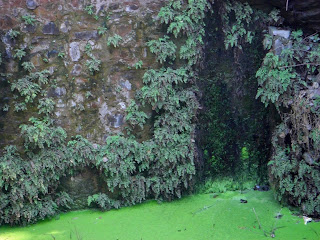 Buffalo again.
Buffalo again.This time they are on the beach.
To be a buffalo, what a life.
 When I first viewed this elaborate cross-over-the-traffic-and-get-to-the-metro system, it looked pretty impressive.
When I first viewed this elaborate cross-over-the-traffic-and-get-to-the-metro system, it looked pretty impressive.
 King George V of England is the whole entire reason I wanted to go see Coronation Park.
King George V of England is the whole entire reason I wanted to go see Coronation Park. It's where the biggest statue in the world of King George V lives.
It's where the biggest statue in the world of King George V lives. You see, he started out under the canopy near India Gate. But at the time of independence, he was removed to Coronation Park.
You see, he started out under the canopy near India Gate. But at the time of independence, he was removed to Coronation Park. The Coronation Park that is now a construction zone and a mess of mud and brick.
The Coronation Park that is now a construction zone and a mess of mud and brick. Don't be embarrassed by being in the graveyard of statues. Someday this will be a nice park and maybe someone will come to visit you.
Don't be embarrassed by being in the graveyard of statues. Someday this will be a nice park and maybe someone will come to visit you. Way out north, there is a
Way out north, there is a So they were moved all together to a new location.
So they were moved all together to a new location. In the move and over time, the identities of most of these statues were lost. Former viceroys, military officers... the whole place was forgotten and unvisited.
In the move and over time, the identities of most of these statues were lost. Former viceroys, military officers... the whole place was forgotten and unvisited. Until recently, when the Delhi centennial was in the news and someone paid attention to it.
Until recently, when the Delhi centennial was in the news and someone paid attention to it. It should be nice when it's actually finished.
It should be nice when it's actually finished. But for the time being, we were walking around amongst the mud and dirt and unlaid bricks. We would not have been let in to a place like that in the US.
But for the time being, we were walking around amongst the mud and dirt and unlaid bricks. We would not have been let in to a place like that in the US.


 Hooray for sighting another baoli!
Hooray for sighting another baoli!
 Even so, it has a nice green color and I would have been sorry to miss it...as we almost did.
Even so, it has a nice green color and I would have been sorry to miss it...as we almost did. A short walk away from the Mutiny Memorial is Pir Ghaib.
A short walk away from the Mutiny Memorial is Pir Ghaib. Pir Ghaib is named for the 'Disappearing Saint'. The story goes that a holy man came to this remote area to meditate. People would come to him with their requests and gone was his peace and quiet.
Pir Ghaib is named for the 'Disappearing Saint'. The story goes that a holy man came to this remote area to meditate. People would come to him with their requests and gone was his peace and quiet. The buildings are from around 1360 when Firoz Shah Tuglak--who also used to visit the saint--built himself a hunting lodge and what seems to be an observatory here.
The buildings are from around 1360 when Firoz Shah Tuglak--who also used to visit the saint--built himself a hunting lodge and what seems to be an observatory here. The British built this Gothic style tower in 1863 in memory of the soldiers who died in 1857.
The British built this Gothic style tower in 1863 in memory of the soldiers who died in 1857. It seems they really took this event to heart, as it is covered with elaborate detail and plaques filled with information of
It seems they really took this event to heart, as it is covered with elaborate detail and plaques filled with information of  who and how many died or were wounded.
who and how many died or were wounded.
 The tower stands above the treeline and can be seen from a distance. But, understandably, it is not often visited.
The tower stands above the treeline and can be seen from a distance. But, understandably, it is not often visited.  My neighbors lit a fire in the middle of their living room floor.
My neighbors lit a fire in the middle of their living room floor.
 Here's another decked out ambassador.
Here's another decked out ambassador.